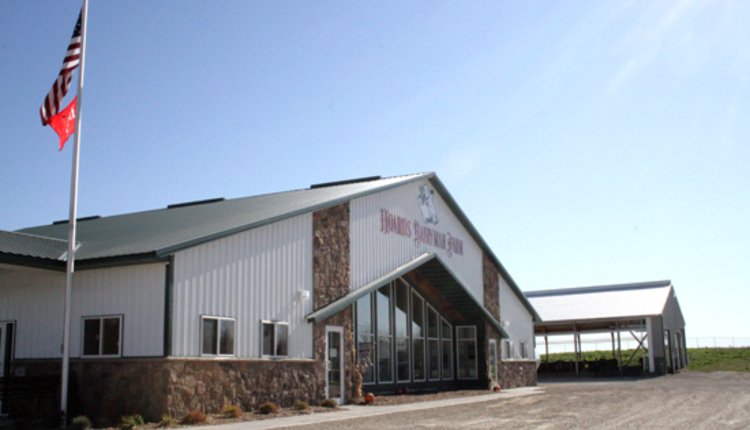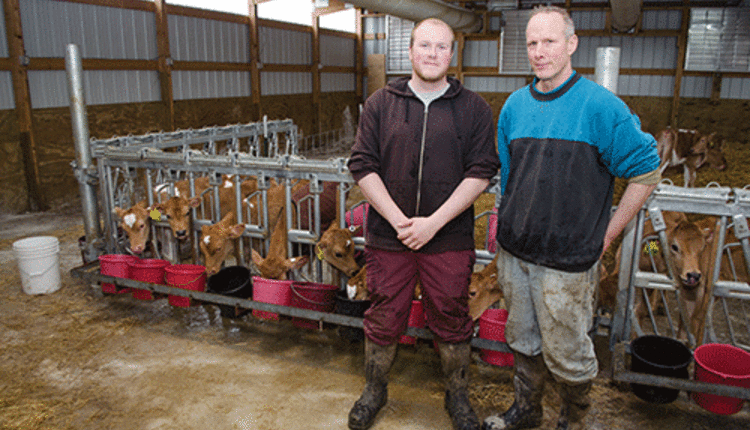
Aerial view of the farm today . . .
The magazine's founder, W.D. Hoard, acquired the Hoard's Dairyman Farm in 1899. He purchased the farm to experiment with new ideas such as growing alfalfa and to try out new herd care practices that would potentially benefit the readers of Hoard's Dairyman magazine. To this day, the farm remains an important part of the magazine allowing its employees, especially its editors, to maintain a close tie with what happens on dairies and acts as a learning center for new ideas. The Hoard's Dairyman Farm is listed on the National Registry of Historic Places by the United States Department of the Interior to recognize W.D. Hoard's pioneering work with alfalfa research and his impact on the dairy industry.
This guide will give you a visual tour of the modern day Hoard's Dairyman Farm.
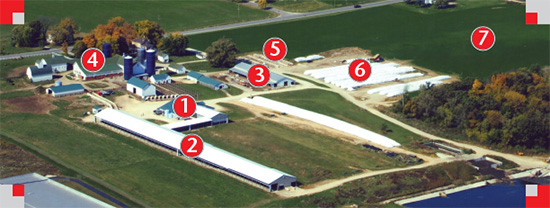
- Milking parlor
- Freestall barns
- Prefresh and maternity barn
- Original buildings
- Calves and heifers
- Feeding
- Crops
1. Milking parlor
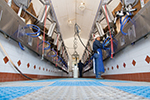 Built in 2007, the milking parlor is a rapid exit double-10 herringbone parlor. It is a basement-type parlor with milk and vacuum lines, pumps and compressors in a lower level. The parlor is equipped with teat scrubbers that wash, sanitize and dry teats prior to milking. The cows are milked three times a day at 4 a.m., noon and 8 p.m. by two employees, while a third brings the cows from the barns, scrapes alleys and cleans freestalls. The farm's herd is one-third Guernseys and two-thirds Jerseys that average more than 20,000 pounds of milk, 960 pounds of fat and 730 pounds of protein per lactation. When the milk leaves the farm, it goes to Torkelson Cheese Company in Lena, Ill., where it is made into Brick, Muenster, Quesadilla and Asadero cheeses.
Built in 2007, the milking parlor is a rapid exit double-10 herringbone parlor. It is a basement-type parlor with milk and vacuum lines, pumps and compressors in a lower level. The parlor is equipped with teat scrubbers that wash, sanitize and dry teats prior to milking. The cows are milked three times a day at 4 a.m., noon and 8 p.m. by two employees, while a third brings the cows from the barns, scrapes alleys and cleans freestalls. The farm's herd is one-third Guernseys and two-thirds Jerseys that average more than 20,000 pounds of milk, 960 pounds of fat and 730 pounds of protein per lactation. When the milk leaves the farm, it goes to Torkelson Cheese Company in Lena, Ill., where it is made into Brick, Muenster, Quesadilla and Asadero cheeses.2. Freestall barns
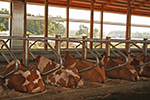 Most of the milking herd is housed in a naturally ventilated freestall barn that was built in 2007. Jerseys are also housed in the 120-year-old tiestall barn that was converted to freestalls in 2010. The farm has been home to Guernseys since it was founded in 1899, and the Jerseys were added in 2009. The freestalls are bedded with sand, and the alleys are scraped during each milking.
Most of the milking herd is housed in a naturally ventilated freestall barn that was built in 2007. Jerseys are also housed in the 120-year-old tiestall barn that was converted to freestalls in 2010. The farm has been home to Guernseys since it was founded in 1899, and the Jerseys were added in 2009. The freestalls are bedded with sand, and the alleys are scraped during each milking.3. Prefresh and maternity barn
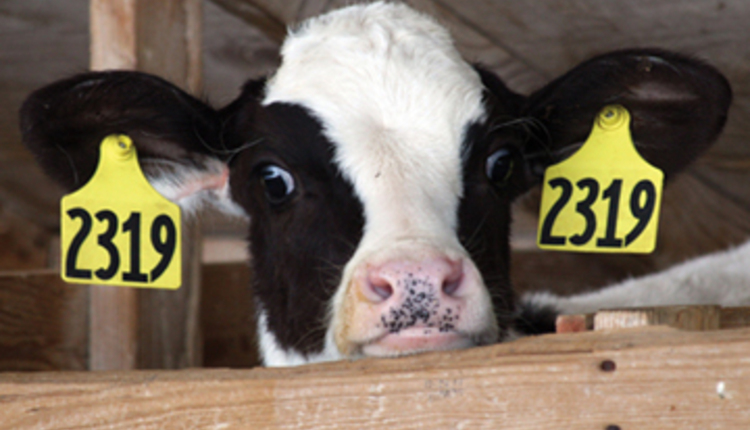 The barn was built in 1976 as a freestall facility for heifers and dry cows. As the operation grew, our close-up cows required more room, so the freestalls were removed and replaced by a straw bedded pack. Cows are moved into the barn three weeks prior to calving, and heifers are moved in four weeks before their due date. The heifers and cows stay in the barn until calving and then are moved into the milking herd. When signs of calving begin, the cows are moved to individual calving pens.
The barn was built in 1976 as a freestall facility for heifers and dry cows. As the operation grew, our close-up cows required more room, so the freestalls were removed and replaced by a straw bedded pack. Cows are moved into the barn three weeks prior to calving, and heifers are moved in four weeks before their due date. The heifers and cows stay in the barn until calving and then are moved into the milking herd. When signs of calving begin, the cows are moved to individual calving pens.4. Original buildings
 In 1899, W.D. Hoard purchased a farmhouse that sat on 100 acres. During Hoard's life, the farm was called Prospect Farm, but following his death, the farm was renamed because exclusive use of the name Prospect Farm could not be obtained. The house was built in 1845 by Asa Snell, and it is the same structure that stands on the Hoard's Dairyman Farm today. The two-story, brick structure has always been the home of the farm manager.
In 1899, W.D. Hoard purchased a farmhouse that sat on 100 acres. During Hoard's life, the farm was called Prospect Farm, but following his death, the farm was renamed because exclusive use of the name Prospect Farm could not be obtained. The house was built in 1845 by Asa Snell, and it is the same structure that stands on the Hoard's Dairyman Farm today. The two-story, brick structure has always been the home of the farm manager. Along with the house, Hoard purchased several buildings including a dairy barn still used today and a horse barn that is now used to house some nonlactating cows. Throughout the 20th century, additional buildings were constructed to meet the needs of the growing farm including grain bins, a machine shed, a bull barn and hay sheds. The Hoard's Dairyman Farm has also been home to other livestock including swine and chickens that were housed in a chicken coop that still stands on the property and a farrowing barn that has been converted into a barn that houses bull calves in the winter.
5. Calves and heifers
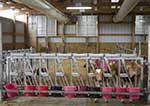 After birth, the calves are fed colostrum and given immunizations. At 3 to 5 days old, calves are moved to a family farm about 30 minutes away where they are cared for until a month before they are due to calve.
After birth, the calves are fed colostrum and given immunizations. At 3 to 5 days old, calves are moved to a family farm about 30 minutes away where they are cared for until a month before they are due to calve. 6. Feeding
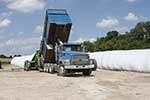 The cows are fed a total mixed ration (TMR) twice a day that includes homegrown alfalfa silage and corn silage, as well as homegrown corn grain, a custom protein mix, liquid whey, wet brewers grains, vitamins and minerals. The silages are stored in white 12-foot diameter bags that are located on gravel pads. Each year, the farm harvests around 13,000 combined tons of corn and alfalfa silage.
The cows are fed a total mixed ration (TMR) twice a day that includes homegrown alfalfa silage and corn silage, as well as homegrown corn grain, a custom protein mix, liquid whey, wet brewers grains, vitamins and minerals. The silages are stored in white 12-foot diameter bags that are located on gravel pads. Each year, the farm harvests around 13,000 combined tons of corn and alfalfa silage.7. Crops
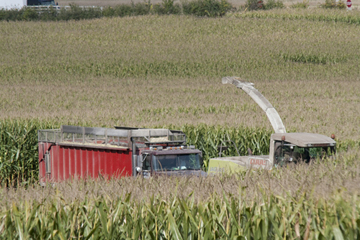 The farm has 872 acres of cropland, which provide most of the feed needed for the herd. Half of the total acreage raises corn, while the rest is seeded to alfalfa and some wheat. Custom operators complete most of the fieldwork, which allows the dairy's employees to focus on the cows.
The farm has 872 acres of cropland, which provide most of the feed needed for the herd. Half of the total acreage raises corn, while the rest is seeded to alfalfa and some wheat. Custom operators complete most of the fieldwork, which allows the dairy's employees to focus on the cows. 






